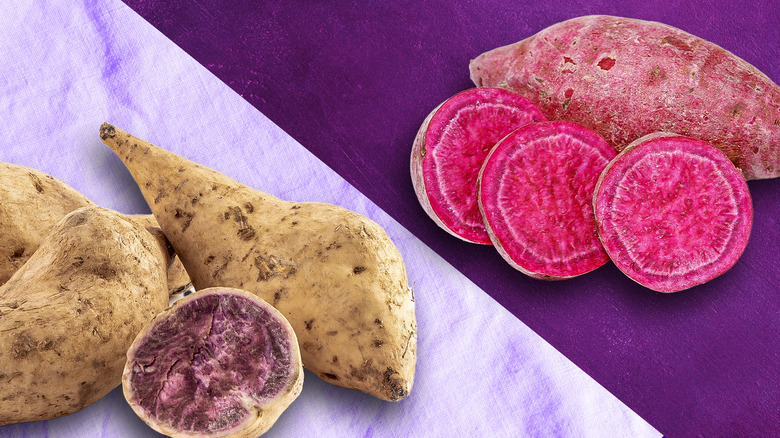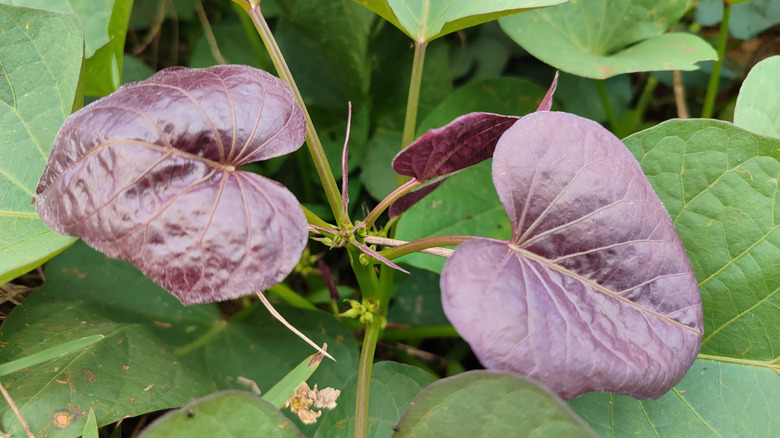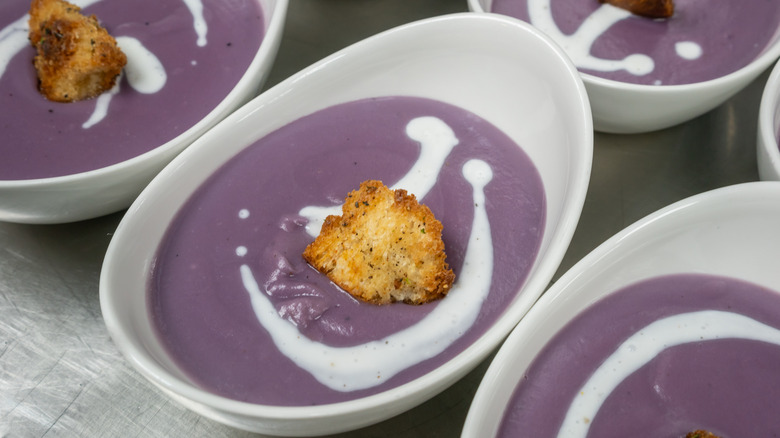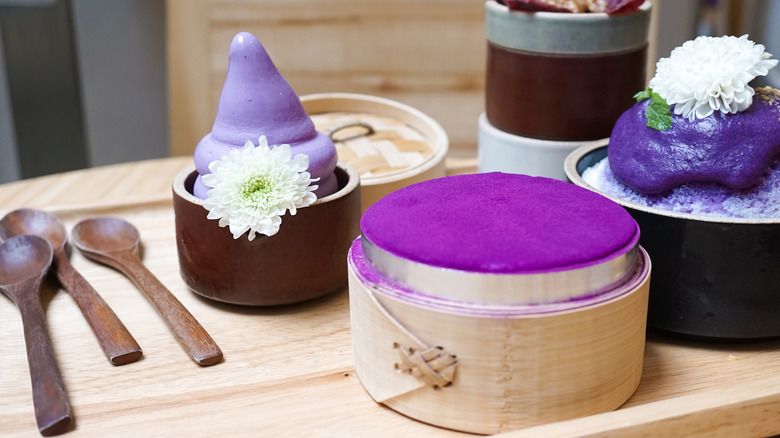The Differences Between Okinawan And Molokai Purple Sweet Potatoes
Sweet potato fans, listen up: Purple versions of this tasty root veggie definitely deserve some kitchen love — if you can find them. Most are regionally specific and can be seasonal, but it's well worth the extra procurement effort. Two in particular carry more nuances than you'd imagine, with deep ties to the Hawaiian Islands. Those earthy, highly nutritious tubers go by the names of Okinawan and Molokai purple sweet potatoes.
When comparing types of sweet potatoes, it helps to first know that any sweet potato is distinctly different from any white potato. They're from separate families altogether, with white potatoes hailing from the Nightshade clan and sweet potatoes belonging to the Morning Glory family. Both Molokai and Okinawan purple sweet potatoes are therefore Morning Glory relatives, albeit without the standard orange flesh of typical sweet potatoes.
Similar to more readily accessible mainland U.S. versions such as Stokes purple sweet potatoes from North Carolina, the Molokai and Okinawan purples carry purple or reddish flesh, and both harbor remarkable amounts of a valuable antioxidant. However, the two Pacific region variants diverge slightly in traits such as taste, texture, heritage, availability, and best-use cooking applications. Here's a deeper look at these tasty, nutritious tubers, including how to enjoy them in your own home.
What are Okinawan sweet potatoes?
Okinawan sweet potatoes populate many home and restaurant menus in the chain of Hawaiian islands, but they traveled a long way to get there. Origin stories range from ancient Aztec civilizations to other parts of South America, the Philippines, China, and finally to the Pacific island of Japan in the 1600s. As such, they got their name from Okinawa, one of the five main islands of Japan, which received the first root plantings of the purple potatoes.
After arriving in the Hawaii islands, Okinawan sweet potatoes, also known as beni imo, became deeply engrained in island food culture. They're now so prolifically grown and eaten that many locals simply call them Hawaiian sweet potatoes. At first glance, they can be hard to distinguish from so-called white potatoes, because the skins themselves have beige coloration. However, slicing into an Okinawan immediately dispels any misconception, with an unmistakable burst of color from purple, deep blue, or dark magenta flesh.
What are Molokai sweet potatoes?
The island of Molokai is lesser known to tourists but has played a significant part in Hawaiian culture for centuries. It's the fifth largest island in the chain, perching about eight miles across the water from Maui, and is highly populated with Native Hawaiians living rural or farm-based lifestyles. That includes the generational family that cultivated the namesake Molokai purple sweet potatoes.
These purple sweet potatoes are distinct from the more widespread Okinawan/Hawaiian purple tuber, with the Molokai being nurtured, developed, and grown only on Molokai. Starting with the labors of "Grandmother Becky" Mokuau, three generations of Molokai sweet potato farmers still thrive under the Decoite family-owned L&R Farms in rural Molokai. The Molokai variant has the same purple coloration in both the skin and flesh, compared to the Okinawan with beige skin.
The growers credit Hawaiian sunshine, pristine water, and nutrient-laden volcanic soils for producing the distinct flavor and quality of all their sweet potatoes, including the Molokai purples. Though a small-production vegetable, it's still a mainstay of Hawaiian luaus and eateries, and it has been lauded by famous chefs such as Emeril Lagasse and Hawaiian celebrity chef Sam Choy.
Comparing the taste and texture of Okinawa and Molokai purple sweet potatoes
Okinawan (aka Hawaiian) purple sweet potatoes have a mild taste reminiscent of sweet honey. Some people describe them as having a flavor similar to wine. The texture of the flesh when raw tends to be dry and starchy but turns from tough to creamy after cooking. They have a thin outer skin that's edible, so there's no need to peel them unless preferred.
The Molokai purples have a thicker skin that some describe as challenging to slice through. But the flesh of this variety also softens considerably when baking, roasting, or boiling, resulting in tender, moist, sweetness. There's a subtle nutty undertone that can taste like chestnuts. The heart-shaped leaves are edible as well, imparting sweet grassy vegetal tones to stir-fries, soups, and curries. Like standard sweet potato leaves, they're tasty as a side dish prepared similar to spinach or other cooked greens.
Cooking applications are similar for Molokai and Okinawan varieties
Okinawan and Molokai purple sweet potatoes can be used interchangeably in recipes, as they have similar sweet flavors and textures. The Okinawan ones will likely be easier to find outside of Hawaii, as major online vendors make them available in multi-pound portions. Many popular dishes featuring Hawaiian purple sweet potatoes involve Japanese preparations such as deep-fried, battered tempura, or sweeter sushi rolls. They're also an excellent filling for the Hawaiian take on Chinese bao buns, as you can tuck mashed Molokai or Okinawan potatoes into manapua dough.
A plethora of Hawaiian-influenced specialties exist as well, such as creamy purple sweet potato soup or a simple mashed sweet potato side dish originating in Kauai. It calls for boiling purple sweet potatoes and mixing them with coconut milk and salt or sugar to taste. Because of the nutty, savory nature of the Molokai variety, it's a shoo-in for classic Hawaiian lau lau dishes featuring fish and pork.
Easier ways to cook with both potatoes include slowly roasting in the oven to coax and caramelize those natural sugars tucked inside the skins, or simply substituting purples into standard orange sweet-potato recipes. Then there's the sweet stuff, stirring them into desserts such as pies, mochi, and soft ice creams. You can also be adventurous and try making crispy purple sweet potato tarts topped with a sweet potato paste or spread. For a quick snack with zero cooking, pick up a bag of crunchy Hawaiian purple sweet potato chips.
Both Hawaiian-style sweet potatoes carry extraordinary amounts of nutrition
Some extraordinarily beneficial nutrients lie inside those brilliant purple hues of Okinawan and Molokai sweet potatoes. The color comes from anthocyanins, which pack the potatoes with concentrated antioxidants that can boost the immune system and potentially help reduce inflammation, heart disease, diabetes, and the risks of certain types of cancer while also improving one's eye health. They also provide solid amounts of beta-carotene and various vitamins.
That blue-purple-red pigment is familiar to many people through popular fresh produce such as grapes, cherries, strawberries, pomegranates, black plums, and blueberries. Veggies, including purple eggplant, radishes, and red onions, bring the goodness as well, and they're also tucked into black beans and black soybeans. But purple sweet potatoes typically carry much higher amounts, including an impressive three times more beneficial anthocyanins than standard blueberries. A good way to gauge the health benefits you're getting from sweet potatoes is to note the color intensity — the deeper the purple, blue, and violet hues, the greater the antioxidant activity.





